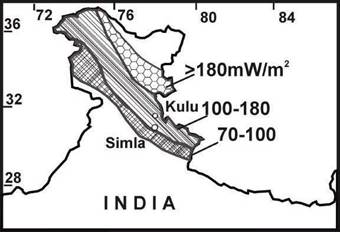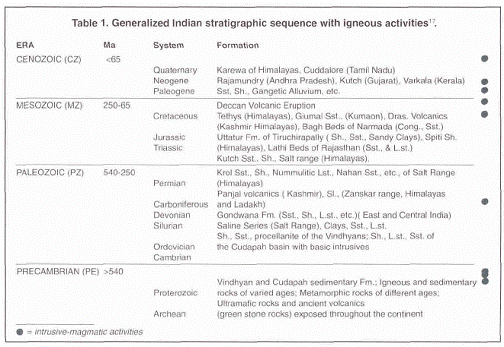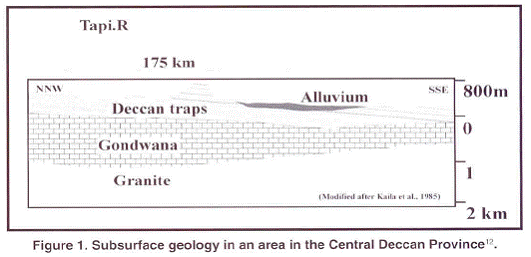| |
Abstract
A large data base on geological, geophysical and subsurface geological information on the wet hot rock geothermal provinces is now available to exploit this energy resource. Besides wet hot rocks, Himalaya Geothermal province has excellent hot dry rock sites for future exploration and ex- ploitation. This province falls within the Indo-Tibet collision zone and sufficiently large plutons occur within this zone which can be exploited for future energy needs of the state. With participation of local government and investment from independent power producers, this energy source can developed to meet the energy demands of the hill rural population.
Introduction
Nearly 70% of India's power production is based on thermal because of the availability of huge and inexpensive coal reserves. Excessive use of this source without the use of strategies to mitigate its effects will have deteriorating effect on the quality of human life in future. In another decade emission of CO2, SO2 and Nx will exceed 1500 million tones, 1900 kilo tones and 1200 kilo tones respectively (World Bank Report 1999). This means CO2 emissions will be 775 million metric tones per year as compared to 1000 million metric tones per year produced in the entire European Union! There is no doubt that the cost of electricity produced from coal is far less expensive compared with other fuels. The present day cost of one unit of power is less than US$ 0.02 in the case of coal based power while liquid fuel based power costs about US$ 0.04 per unit (Mehta, 1999) and hydro power costs about US$ 0.03 (World Bank Report, 1999). But the expenditure spent to meet the consequences (like disposal of fly ash; treating the high ask coal etc) is high which automatically increases US$ 0.02 a unit to little over 1 US$. Now a time has come to look into those alternate energy sources which were not viable a decade ago due to non availabilities of technical know how. At present 1.5 percent of total power generation capacity comes from non-conventional energy sources like wind, solar and bio-mass (Chandrasekharam, 2000). In the next fifteen years, according to the World Bank report (World Bank report, 1999), this energy supply could increase by seven times and above. India can not ignore its huge energy resource available from wet and hot dry rocks in future.
Hot Dry Rock Province
Out of the seven geothermal provinces, projects have been initiated to tap power from the wet hot rocks from one of the central geothermal provinces (Tattapani) and serious consideration is being given to tap this energy from other provinces. Besides wet rocks, Indian geothermal provinces have excellent sites to initiate hot dry rock projects. The three important criteria a site should satisfy to be HDR prospect are a) a substantial mass of hot rock should be available at a reasonable depth, b) the region with such mass of hot rocks should be under compressional stresses and c) this hot rock should have a insulating cover above to sustain the heat generated by the radioactive decay of U and Th.. There is one such excellent province, the Himalaya geothermal province which satisfies all these conditions. This paper examines the geological, geophysical and tectonic aspects of this province. Below figure shows all the sub-provinces in the Himalaya. These provinces lie parallel to the Indo-Asia collision zone (Main Central Thrust and Indo-Tibet Suture Zone). The entire geothermal province covers an area greater than 1500 sq.km. The heat flow value varies from 70->180 mW/m2. The thermal waters issuing in this province record temperatures as high as 98oC and some times are associated with high steam content (Chandraekharam, 2000). The geothermal gradient recorded from shallow bore-wells is greater than 100oC/km. Such high heat flow and geothermal gradient are due to high radioactive elements present in the granites and also due to the presence of seismic bright spots (discussed below) in this region. The Himalaya geothermal province falls within the Asia-Indian plate collision zone and the main central thrust (MCT) passes through this geothermal province. Besides Precambrian and sedimentary formations related to the fore-arc basin, this provinces encloses a large number of granite intrusives which vary in age from 60 to 5.3 Ma (Schneider et al., 1999; Searle, 1999; Le Fort and Rai, 1999; Haris et al., 2000; Harrison et al., 1998, 1999). These granites are exposed on the surface at several places and are covered by sedimentary formations at several places. These granites occur as lopoliths, sheets and dykes (leucogranites) which vary in thickness from a few meters to several kilometers. Permian Granites of 268 Ma also occur in the western Zanskar (Noble et al., 2001). International Deep Profiling of Tibet and the Himalayas (INDEPTH) project located seismic bright spots in Tibet region (East of the Indian Geothermal Provinces) which are
attributed to the presence of magmatic melts and or saline fluids within the crust (Makovsky and Klemperer, 1999). Highly saline fluids are also found in Ladakh granites (~60 Ma) as inclusions which are attributed to the high volatile content in the granitic melts (Sachan, 1996). Though INDEPTH investigation has not been carried out, considering the proximity of INDEPTH site in Tibet, probability of occurrence of such seismic bright spots within the Himalayan geothermal province is high. This inference gains strength from the 1 Ma anatexis process recognized in Nanga Parbat (Chichi granite massive) in Pakistan Himalayas (Schneider et al., 1999) and similar processes must be in operation on the eastern side of Nanga Parbat also. These evidences confirm that the present day observed high heat flow value (>100 mW/m2) and geothermal gradient is related to crustal melting process at shallow depth in this region.
Regional stress analysis based on earthquake focal mechanism, borehole blow- outs and hydrofracturing (Gowd et al., 1992) indicates that the entire Himalayan belt in general and the Himalayan geothermal province in particular, is under compressive stress regime due to the northward movement of the Indian plate and net resistive forces at the Himalayan collision zone. Thus the central and northern India including Nepal, the Great Himalayas and Pakistan fall under this stress province characterized by NNE-ENE oriented SHmax. Investigation carried out around Zanskar (north of Kulu, in the Himalayan Geothermal province) by Pierre Dèzes (1999) also shows compressive regime in this region. Compressional stress regime is favorable to create several sub-horizontal reservoirs in granites by hydrofracturing, interconnected by boreholes ( Baria et al., 1999; Wyborn 2001).
The entire subduction tectonic regime along the Himalayan geothermal province appears to be similar to Hijiori and Kansai provinces in Japan where HDR prospect is being evaluated. International HDR feasibility study can be initiated in this region with Local Himachal Pradesh Govt. support and support from the independent power producers. With the present trend of globalization, incentives given to non-conventional energy power producers, problems in establishing power grid in the hilly terrains of Himalayas and environmental problems associated with coal based power projects, the future of HDR prospects in this geothermal province is very promising.
HDR Prospects of Himalayan Geothermal Provinces
(D. Chandrasekharam)

Top
Granites and Granites:India’s Warehouse of EGS
(Geothermal Resources Council - geothermal Bulletin Vol.37, No.6 – Dec. 2008)
D. Chandrasekharam
Varun Chandrasekharam
There are a very few countries that have the entire stratigraphic column, extending from the Archean to the Recent. India is one such country. Perhaps India is a geological-experimental laboratory where one can achieve insight into the geochemical evolution of the mantle and crust through time. Mantle xenoliths and ultraamafic rocks, representing the mantle and different geological ages, are abundant and have been studied by several researchers. Similarly granites, representing the continental crust, occur as intrusives in early and late stratigraphic units, as shown in table 1. The Precambrian and Post-Carboniferous Eras experienced several magmatic events-represented by granites, basalts, and pegmatites. Post-Carboniterous igneous activities are, in general, concentrated toward the central and northern parts of India, e.g. along the Indus Suture Zone (ISZ), while Precambrian igneous activities are widespread over the whole continent. Unlike other countries, Precambrian gneisses invariably from the basement stratigraphic unit. A generalized Indian stratigraphic sequence with igneous activities is shown in table 1, the dots on the right indicating intrusive-magmatic activities at different geological periods.
The Post-Mesozoic Era experienced intense-plutonic activity in the northern part of India while the southern part of India exposed ancient-crustal rocks forming the basement in both northern and southern areas of the country. The southern part of the Indian continent exposes a variety of older granites that have intruded into the basement of ancient-gneissic rocks. The plutonic activity in the northern part of India is represented by several granites, varying in age from 477 Ma to 5 Ma (maximum-estimated geological age). Recently, granites of 1,450 Ma are reported below the Deccan volcanic flows off the "Mumbai coast". Although the granitic outcrop is discrete, gravity and aeromagnetic anomaly maps a2' indicate the granites occupy a large area below the sediment and the Deccan volcanic cover. Thus the area occupied by these granites is greater by several orders compared with their outcrop areas. In the majority of cases recorded by deep-seismic sounding and electromagnetic investigations, these granites form the basement of the Paleozoic (eg. Gondwana) and Cenozoic (eg. Deccan basalt) formations. A typical subsurface section deduced from DSS (deep seismic sounding) and MT (magneto-tellurics) is given in figgure below.
A rough estimate based on the geological map of India shows that the area occupied by the granitic outcrop is about 150,000sq km. As a specific example, the granite occurring along the Himalayan Geothermal Belt (HGB) is shown in fig 2 below. The granite exposed within the Indian HGB territory covers about 47,925sq km.
Although these granites have evolved over different time periods, one common feature is their high-heat generating capacity due to the high concentration of radioactive elements like U, Th and K (U: 5-14ppm; 3-101ppm; K: 3-5%). The heat-flow values (>50mW/m2), geothermal gradients varying between 57oC/km (along the western coast) to 180oC/km (HGB) and Bouger Gravity anomaly contours over the continent also reflect the extent of buried high-heat generation granites below the sedimentary and volcanic formations (eg.figure 1) extending from the Himalayas to the southern part of the Indian Peninsular. The close relationship among these high-radioactive granites and the geothermal systems in several parts of the continent is clearly demonstrated by the high He content and low3He/4He (reflecting the crustal signature) in the thermal gases. Entire geothermal systems appear to be driven by these buried granitic masses, indicating a natural enhanced-geothermal system in the continent. Long and deep circulating patterns of thermal fluids are reflected by the" high hydrogen content of the thermal gases"' and water-granitic interaction results.


Adopting the procedure reported for "Australian granites" and based on the available heat flow, geothermal gradient, and area of granitic exposure, the geothermal reserves of the granites exposed over an area of 1000 sq km have been calculated for a small area in Ladakh, as shown in figure 2. The calculations are based on the minimum temperature (- 130%) that the granites can generate at depths varying km 2 to 5 km, with known temperatures of the existing geothermal reservoir established in "Yangbajing" and geothermometery based on gas and thermal water chemistry of the Puga geothermal province (unpublished data). Such granites have an EGS reserve of about 61,160 x 102 kwh. At present, Ladakh is generating - 4 x 10%k Wh from diesel generators, while the reported demand is "310 x lob kWh."us the EGS reserve is greater by several factors when compared with the current electncal demand in Ladakh. Similar estimates show that a small part of high-heat generating granites (1000 sq km) in Madhya Pradesh in central India has a reserve of about 24,464 x 1012 kWh, while the present consumption of electricity by the entire state of Madhya Pradesh is about 33 x lo9 kWhP Similarly the current electrical consumption of Andhra Pradesh is 88 x 10' kWh, while the current deficit is on the order of 20-25 x lo9 kWh. Part of the high-heat generating granites of central Andhra Pradesh has a reserve of 111,200 x lo1' kWh.
Thus each Indian state has an enormous volume of granites buried beneath its sedimentary cover. The existing stress regime is conducive to creating suitable geothermal reservoirs to support EGS projects in every state. EGS projects have bright futures in India, as the country is a warehouse of high-heat generating granites.

Top
|
|

